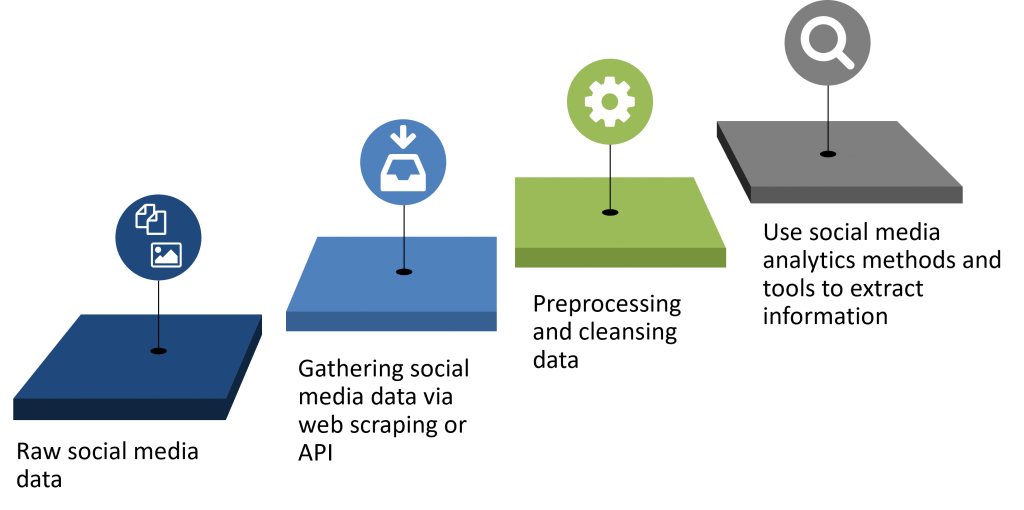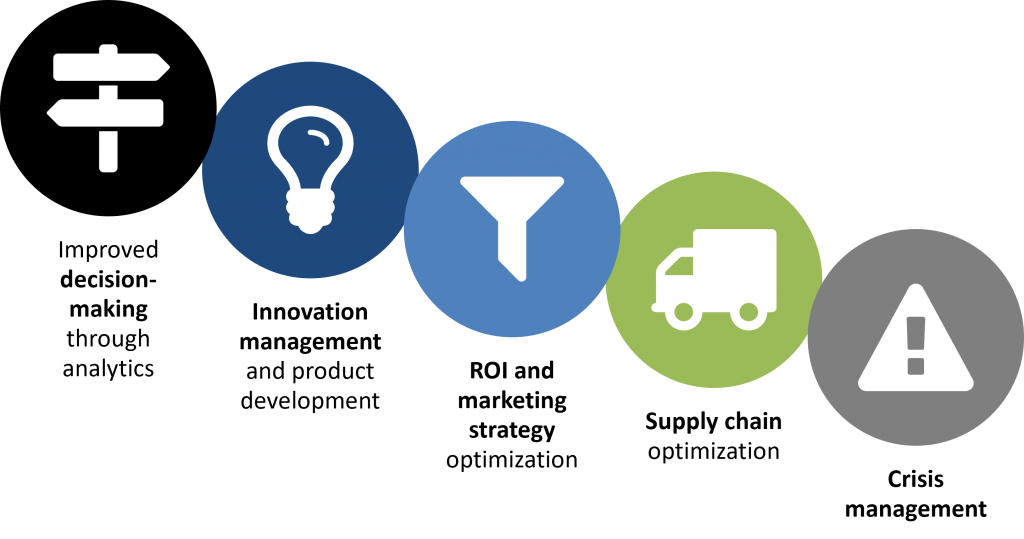Social media platforms have been on the rise for years: The number of users has been increasing steadily and is now at an all-time high of 4.76 billion social media users in 2023 (Statista 2023a). This usage creates vast amounts of social media data (Voorveld 2019) that can potentially be leveraged. According to Batrinca and Treleaven (2015) this data is “the largest, richest and most dynamic evidence base of human behavior” making social media data an interesting resource to understand how people act. The challenge is to make this data usable by using analytics and to create business models based on this data, and thereby create value (Immonen, Pääkkönen, and Ovaska 2015). Therefore, this article aims to provide an overview of the various possible use cases of social media data for businesses by compiling different approaches from scientific and practitioner literature.
The rapid and massive growth of social media platforms eventually resulted in big amounts of social media data, in particular texts, pictures, videos, sounds, locations as well as relationships between people (Stieglitz et al. 2018). Social media data can be characterized as “vast, noisy, distributed, unstructured, and dynamic” (Gundecha and Liu 2012).
Collection of social media data
Due to the vast amount of data, companies and researchers often use technology to collect data instead of manually extracting data from social networks (Krotov and Silva 2018). The two most common ways to automatically collect social media data are web scraping and data scraping via an application programming interface (API) (Dongo et al. 2020). Moreover, there are built-in analytics tools of social media platforms like Facebook and Instagram (e.g., Instagram Insights) which collect and display social media data. In addition, there are several commercial social media data analytics tools on the market that help with the analysis and visualization of data (Grubmüller, Götsch, and Krieger 2013).
Using social media analytics to turn data into value
Social media data can be seen as a valuable resource, but vast amounts of raw, mostly unstructured social media data with partly subjective content cannot be used to directly derive value-adding business decisions (Stieglitz et al. 2014). That’s where social media analytics comes in.

Stieglitz et al. (2014) describe social media analytics as a tool to mine, track and analyze large amounts of raw social media data with the goal to derive valuable insights for various business purposes. For the analysis of text data, text analytics and sentiment analysis are used, which will be discussed in more detail in the following. Social network analysis, on the other hand, focuses on the relationships and characteristics of people (and companies) within a network (Kane et al. 2014). To analyze the growing amount of image and video data, image and video analytics are increasingly being used, some of which are based on artificial intelligence and machine learning (Kumar and Qiu 2021).
Text analytics and sentiment analysis Text analytics (also referred to as text analysis) with the subfield of sentiment analysis (also called opinion mining) has become an established method in social media analytics. Sentiment analysis deals with the automated processing of sentiment, opinions and subjectivity in text (Pang and Lee 2008). One approach to extract sentiment from social media data is to use automated text analytics tools that assign polarity scores, while taking into account the context of a text to finally calculate a score (de Haan and Menichelli 2019).
5 Use cases of social media data for business
How can companies tap in this massive social media data source and specifically create value from this data? The following section focuses on use cases identified from the literature, namely improved decision-making through analytics, innovation management, ROI and marketing strategy optimization, supply chain optimization and lastly crisis management.

Improved decision-making through analytics
There is evidence that the greater use of data in the decision-making process can result in better decisions and, therefore, better business performance (Economist Intelligence Unit 2012). According to a survey among 607 business executives, 40% believe they could have made significantly better decisions if they had had all the structured and unstructured data relevant to that decision (Economist Intelligence Unit 2012). Value is often created by collecting, combining, and analyzing disparate large data sets, such as those from organizations, social media, or the internet of things (Janssen, Van Der Voort, and Wahyudi 2017). Yet, companies should ensure that the social media data used is of high quality as well as that it does not contradict other data, otherwise it can have negative effects on the decision-making process (Huang, Potter, and Eyers 2020).
Innovation management and product development
In fact, for a long time now, information about how people think about products, brands and more has been an important part of the decision-making process (Pang and Lee 2008). In social media data, one can find these pieces of information in form of customer opinions, reviews and trends for large audiences (Chen and Wong 2021). Using social media data in the product development process allows companies to continuously track customers’ immediate thoughts and feelings about products and services and understand changes in customer demand (He, Wang, and Akula 2017; Irani et al. 2017). In other words, businesses can use social media insights as a resource by collecting and using customer opinions, gaining access to user’s knowledge and co-creating new products with users (Huang, Potter, and Eyers 2020; Roberts and Piller 2016).
ROI and marketing strategy optimization
To support marketing decisions like selecting the right target audience and the right channels for different sets of users, marketing professionals can use big data to gain insights into social media trends (Zhang et al. 2022). Huang, Potter, and Eyers (2020) suggest that businesses can use data mining and sentiment analysis to discover customers’ thoughts on social media and use the results to optimize marketing strategies. Hence, if marketing departments use social media analytics proactively, it improves decision-making, allowing marketers to allocate resources where they have the biggest impact, i.e., make decision-making more efficient (Tafesse and Wien 2018) and potentially drive ROI (Bengel, Shawki, and Aggarwal 2015). As a specific application, Bengel, Shawki, and Aggarwal (2015) describe that companies can use tagging in combination with web analytics tools such as Google Analytics to better understand attribution. This means that marketing managers can better understand which channels (e.g., which social media platforms) lead to conversions in which way and can therefore optimize the budget and thus marketing efficiency and ROI.
Supply chain optimization
Demand forecasting is an important aspect of supply chain management, yet it is difficult to forecast due to its complexity and dependence on many factors (Chen and Wong 2021). Understanding customers is key in demand forecasting, and social media data can help integrating customer requirements and sentiment (Huang, Potter, and Eyers 2020). By combining different indicators like volume-based indicators, sentiment analysis and video information, companies can achieve more accurate demand forecasts (Huang, Potter, and Eyers 2020), enabling businesses to increase efficiency and save costs. Related to demand forecasting is the topic of inventory management. According to Irani et al. (2017), businesses can use social media data in their strategic inventory management to support the prediction of orders and needed inventory volume. Chen and Wong (2021) conclude that the use of social media in inventory management potentially can reduce the negative effect of demand uncertainty. Moreover, in the field of supply chain risk management, better risk management can be obtained by using social media analytics to identify risks, disruptions and misinformation (Chen and Wong 2021; Huang, Potter, and Eyers 2020).
Crisis management
For businesses, tracking and managing their companies’ and brands’ reputation – online and offline – is an important topic. Managing crises, here negative customer reactions and sentiment, is important to preserve reputation and align the company’s offering with customer needs (Cirqueira et al. 2020). In the context of crisis management, sentiment analysis is a helpful method to keep track of users’ opinions and brand perceptions. Cirqueira et al. (2020) propose to use “explainable sentiment analysis”, a sentiment analysis method that is enriched with artificial intelligence (AI). This method allows not only to extract polarity scores from social media data, but also collect reasons why the sentiment is negative. This could help to understand the causes of the crisis more quickly, act accordingly, potentially mitigate crises, and thereby create value for business.
Managerial implications and final considerations
Managers should understand the power of social media data in creating value for their organizations. The use cases presented enable businesses to create value in various ways: Improved decisions, processes, products and strategies or lower risks lead to cost savings or increased sales, thereby contributing to the value creation within the company. To find the right strategies and use cases, businesses should analyze their situation and capabilities (Najjar and Kettinger 2013).
On the other hand, managers should also be aware of the challenges in dealing with social media data. Over the last years, the excessive use and analysis of user data has led to concerns regarding ethics, data security and privacy (Appel et al. 2020; Krotov and Silva 2018; Saura, Ribeiro-Soriano, and Palacios-Marqués 2021). Businesses should integrate ethical considerations into their social media data monetization strategy, for example, by using ethical categories such as privacy, informed consent, ethical theory, regulation and geographical information proposed by Conway (2014).
Moreover, businesses should pay attention to the legal situation, especially when gathering and storing social media data. To avoid legal issues associated with the data collection via web scraping, such as violating terms of service and copyright, and causing damage to websites (Krotov and Silva 2018), businesses should prefer to gather data through APIs whenever possible. In addition, companies operating in the European Union should be aware of the requirements of the General Data Protection Regulation (GDPR) when using social media data (Parvinen et al. 2020).
Lastly, managers should pay attention to the quality of the data. Using incorrect or low-quality data for analyses can result in incorrect or suboptimal decisions (Huang, Potter, and Eyers 2020).
